




|
 
|

|

I'll explain it at the end.
So, what's "rational homotopy theory"? One might naively define it as the study of spaces whose homotopy groups are vector spaces over the rational numbers.
But if you think about it, that's pretty weird!
For example, the first homotopy group of a space X, usually called the "fundamental group" of X and denoted π1(X), consists of equivalence classes of loops in X that start and end at our favorite point. Two loops count as equivalent if you can continuously deform one until it looks like the other. If you can do this, we say these loops are "homotopic".
The fundamental group of the circle is Z, the group of integers. The reason is that two loops drawn on the circle are homotopic if and only if they wind around the same number of times - and that number must be an integer! You can walk around the block once and get back home. You can walk around the block twice and get back home. You can even walk around the block -5 times and get back home: the negative number just means you walk around the other way. But you can't walk halfway around the block and be back home!
But suppose you had a space whose fundamental group was Q, the rational numbers. Then you could walk halfway around the block and get back home. That sounds pretty weird - nay, downright impossible!
But part of why it sounds so weird is that it's not right. We really need some other "block" such that walking around that block twice is homotopic to walking around the original block once. This sounds more complicated... but also more possible.
Later in this post I'll describe a space called "the rational circle", whose fundamental group is indeed Q. Then you can see how it actually works.
Anyway: spaces whose homotopy groups are rational vector spaces are weird. Why should we care about them?
We shouldn't! In fact, the real point of rational homotopy theory lies elsewhere.
It's better not to think of rational homotopy theory as the study of weird spaces whose homotopy groups are rational vector spaces. It's better to think of it as the study of ordinary spaces - but viewed in a way that doesn't let us see their homotopy groups, only their homotopy groups tensored with Q. This process turns their homotopy groups into rational vector spaces!
This is a common theme in algebraic topology. We can think of various kinds of homotopy theory either as the completely precise study of rather strange spaces, or as the study of ordinary spaces as seen through a blurry lens. A blurry lens can be a good thing, because it simplifies a complicated picture.
However, even this way of thinking about rational homotopy theory misses the point. The real point is that rational vector spaces come from the land of linear algebra, so rational homotopy blends topology and linear algebra. So does rational homology theory, but rational homotopy theory is deeper. When we get into it, we'll take lots of important concepts from linear algebra - like commutative algebras, and Lie algebras, and Hopf algebras - and study very interesting "homotopy versions" of these concepts.
By doing this, we'll vastly generalize linear algebra. We'll wind up with a whole new perspective... and we'll see applications to physics ranging from classical field theory, to quantization, to supergravity!
And you should not be surprised that we're doing here is really categorifying linear algebra.
But more on that later. Today, I want to start with the naive viewpoint that rational homotopy theory is about spaces whose homotopy groups are rational vector spaces.
In algebraic topology, the really hard part is torsion. A group element is "torsion" if you can add it to itself a bunch of times and get zero. So, for example, every element of a finite group is torsion, but the group of integers is "torsion-free".
Look at some homotopy groups of spheres and you'll see what I mean:
π3(S2) = ZThese are the homotopy groups π2n-1(Sn). If you were asked to make a guess about the torsion-free part of these groups, you could easily formulate a conjecture: it's Z when n is even, and trivial when n is odd. And this is true.
π5(S3) = Z/2
π7(S4) = Z x Z/12
π9(S5) = Z/2
π11(S6) = Z
π13(S7) = Z/2
π15(S8) = Z x Z/120
π17(S9) = Z/8
π19(S10) = Z x Z/8
But if you were asked to make a guess about the torsion part of these groups, you'd find it a lot harder. And indeed, nobody knows the full story here.
This suggests trying to do a version of algebraic topology where we systematically get rid of torsion. We'll lose a lot of important information, but things will get easy and fun - and still far from trivial!
This is "rational homotopy theory".
How can we get rid of torsion?
Well, the nth homotopy group of a compact manifold, like a sphere, is always finitely generated - and abelian when n > 1. A finitely generated abelian group always looks like Zn × T where T is finite. All the torsion is in T, so to get rid of torsion we can just throw out T.
But that doesn't work in general. In general, the nth homotopy group of a space can be any group when n = 1 - and any abelian group when n > 1.
For an arbitrary abelian group, the torsion elements always form a subgroup, called the "torsion subgroup". It's not true in general that an abelian group is the product of its torsion subgroup and some other group! But, we can still kill off the torsion by modding out by the torsion subgroup.
For a nonabelian group, the torsion elements don't necessarily form a subgroup! For example, take the free group generated by x and y, and mod out by the relations x2 = y2 = 1. Then x and y are torsion elements, but xy is not.
I don't know any good way to kill off the torsion for an arbitrary nonabelian group. A lot of work on rational homotopy theory sidesteps this issue by working only with "1-connected" spaces. These are spaces that are path-connected and also simply connected. That means the fundamental group is trivial - and the higher homotopy groups are always abelian, so we don't have to worry about nonabelian groups.
Now, I've made it sound like the right way to "kill off torsion" in an abelian group is to mod out by its torsion subgroup. This makes me wonder if there's a systematic way to take a space X and turn it into a space X' such that πn(X') is πn(X) mod its torsion subgroup. Does anyone know?
But anyway, this is not how we kill off torsion in rational homotopy theory!
Instead, here's what we do. Abelian groups are the same as Z-modules where Z is the ring of integers. Since Z is commutative, we can take tensor products of Z-modules. In other words, we can take tensor products of abelian groups. And to kill off the torsion in an abelian group, we just tensor it with the rational numbers!
I hope you see what this accomplishes. Tensoring an abelian group G with the rational numbers gives a new abelian group Q ⊗ G that includes elements like
q ⊗ g
where g ∈ G and q is a rational number. Any element g of G gives an element of Q ⊗ G, namely
1 ⊗ g
But we also get elements like
(1/2) ⊗ g
which acts like "half of g". More generally, given any element of Q tensor G, we're allowed to multiply it by any fraction.
Now, suppose g is a torsion element of G. Then ng = 0 for some n, so
1 ⊗ ng = 0,
If we multiply both sides by 1/n, we get
1 ⊗ g = 0
So, torsion elements of G get sent to zero in Q ⊗ G. We've killed the torsion.
But the great thing about this trick is that Q ⊗ G is even better than a torsion-free abelian group. It's a vector space over the rational numbers! So, we're not just killing off torsion. We're going from the world of abelian groups to the world of linear algebra, which is notoriously well-behaved.
Next let me sketch how we can take a 1-connected space X and "rationalize" it, obtaining a new space XQ with
πn(XQ) = πn(X) ⊗ Q
for all n.
Since we're doing homotopy theory, we can assume X is a "CW complex". A space of this sort is built from balls. To build a CW complex, we start with some 0-balls - that is, points. Then we take some 1-balls - that is, intervals - and glue their boundaries to the 0-balls. We get a space that's just a graph. Then we take some 2-balls - that is, disks - and glue their boundaries to the space we've got so far. Then we take some 3-balls and glue their boundaries to what we've got so far. And so on, ad infinitum. Any space is "weakly homotopy equivalent" to a space of this sort, and that's good enough for us.
So, to rationalize X we should rationalize this whole procedure! This procedure relies on balls - and also spheres, since the boundary of a ball is a sphere. So, we should define a "rational n-ball" and a "rational n-sphere", and then make sure that given a CW complex, we can build a new space where each ball or sphere we used has been replaced by a "rational" one!
I'll describe the rational n-sphere, since that's the fun part. Even though we don't need it here, let's start with the case n = 1: the "rational circle". As mentioned earlier, this is a space whose fundamental group is Q. Here's one way to build it.
First, take an ordinary circle, and take a cylinder, and glue your circle to the bottom of that cylinder. But: make sure the circle goes around the bottom of the cylinder twice! See what this accomplishes? It means that walking around your original circle once is homotopic to walking around the top of the cylinder 2 times.
This solves our problem of how walking once around the block can be the same as walking twice around some other block.
Then take another cylinder, and glue the top of your first cylinder to that. But: make sure the top of your first cylinder winds around the bottom of this new one 3 times.
Then take yet another cylinder. Glue the top of your second cylinder to the bottom of that - but make sure it wraps around the bottom 4 times.
And then do this forever...
...and then take a little rest, since it's very tiring to do an infinite amount of work. Sit back and admire your handiwork. The space you've built has Q as its fundamental group, because for any loop g and any integer n, we've created a new loop h such that g = nh.
Mathematicians call this general type of space a "telescope". An ordinary hand telescope - the kind that pirates use - is built from cylinders of metal that fit into each other:

A mathematician's telescope is similar - but it's built from infinitely many cylinders, and you can't collapse it, because they're attached to each other in a complicated way. This makes it really easy to spot a mathematician in a roomful of pirates.
We can easily generalize this telescope idea to construct the "rational n-sphere". The point is that for each integer k, there's a way to wrap the n-sphere around itself k times. So, we can use these to build an infinite telescope, just as we did for the rational circle. This telescope is a space whose homotopy groups are those of the n-sphere, but tensored with the rational numbers.
A similar trick produces a rational n-ball, but this is less exciting, since all the homotopy groups of the n-ball were trivial already - it's contractible, after all. The rational n-ball is still contractible, but it's been modified so that its "boundary" is a rational n-sphere.
Having rationalized our spheres and balls, we also need to check that the maps we used to build our CW complex extend in a canonical way from the spheres to the rational spheres. But let's skip this: in This Week's Finds we only do the fun part!
As you can see, the rationalized version of a nice little CW complex is usually a huge nightmarish space. This is a familiar tradeoff in algebra topology: spaces with comprehensible homotopy groups almost always look big and scary when we try to build them by gluing balls together. But it's a tradeoff algebraic topologists have learned to accept. There's more to life than whether a space looks nice.
In particular, this rationalization process has a very nice abstract characterization. Suppose X is any 1-connected pointed space. Then we can define "a rationalization" of X to be any 1-connected pointed space X' equipped with a map
X → X'
satisfying two properties. First, X' is a "rational space": a 1-connected pointed space whose homotopy groups are rational vector spaces. Second, the induced map
Q ⊗ πn(X) → Q ⊗ πn(X')
is isomorphism for all n.
It turns out that the rationalization of a space is unique up to weak homotopy equivalence. And we can construct it for CW complexes as I just explained.
Okay. So far I've been treating rational homotopy theory as the study of weird "rational" spaces. And I've showed you how to turn any space into one of these. But as I already admitted, this misses the point.
To come closer to the point, we need to recall an amazing old theorem due to J. H. C. Whitehead, which says a map
f: X → Y
between connected CW complexes is a homotopy equivalence if and only if the induced maps
πn(f): πn(X) → πn(Y)
are isomorphisms for all n. This is why for more general connected spaces we define any map that induces isomorphisms on homotopy groups to be a "weak homotopy equivalence". Even better, every space is weakly homotopy equivalent to a CW complex! So, if we formally throw in inverses to all weak homotopy equivalences, we get a category called where every space is isomorphic to a CW complex. This is called the "homotopy category".
These ideas are very powerful, so it's good to generalize them to rational homotopy theory. So now suppose X and Y are 1-connected pointed spaces. And let's say a map
f: X → Y
is a "rational homotopy equivalence" if the induced maps on rational homotopy groups
Q ⊗ πn(f): Q ⊗ πn(X) → Q ⊗ πn(Y)
are isomorphisms for all n. There's a nice category where we formally throw in inverses to all rational homotopy equivalences. This is called the "rational homotopy category".
In the rational homotopy category, we're studying ordinary spaces through a blurry lens, because two spaces that have a rational homotopy equivalence between them look the same.
But the rational homotopy category is equivalent to a subcategory of the usual homotopy category: namely, the subcategory consisting of rational spaces and all morphisms between those! So, we can also say we're studying strange spaces, but with complete precision - or at least, the usual level of precision in homotopy theory.
To learn more, I urge you to grab this and take a look:
2) Kathryn Hess, Rational homotopy theory: a brief introduction, in Interactions Between Homotopy Theory and Algebra, ed. Luchezar L. Avramov, Contemp. Math 436, AMS, Providence, Rhode Island, 2007. Also available as arXiv:math.AT/0604626.
For even more detail, I recommend:
3) Yves Felix, Stephen Halperin and Jean-Claude Thomas, Rational Homotopy Theory, Springer, Berlin, 2005.
I'll give more references later. In the weeks to come, we'll see two very different descriptions of the rational homotopy category, which were both discovered by Daniel Quillen back in 1969:
4) Daniel Quillen, Rational homotopy theory, Ann. Math. 90 (1969), 205-295.
It's these other descriptions that make the subject really interesting. One is based on a homotopy version of Lie algebras. The other is based on a homotopy version of commutative algebras!
In the first sentence of his paper, Quillen defines the rational homotopy category. But he does it a bit differently than I just did. This is worth understanding. He says it's "the category obtained from the category of 1-connected pointed spaces by localizing with respect to the family of maps which are isomorphisms modulo the class in the sense of Serre of torsion abelian groups".
Let me say this with less jargon. Start with the category of 1-connected pointed spaces. Throw in formal inverses of all maps
f: X → Y
for which the induced maps
πn(f): πn(X) → πn(Y)
have kernels and cokernels where all elements are torsion. This gives the rational homotopy category!
I'll conclude with a few remarks that would have been a bit too distracting earlier.
First: I discussed rational homotopy theory only for 1-connected spaces. This is great as far as the connection to algebra goes. But in terms of topology it's a bit sad. Sometimes people go a step further and work with "nilpotent" spaces. These are spaces where the fundamental group is nilpotent and acts nilpotently on the higher homotopy groups.
Second: the rational circle is an interesting space. As we've seen, it's a space with the rational numbers as its fundamental group. All its other homotopy groups are trivial, since that's already true for the circle.
Any space with G as its nth homotopy group and every other homotopy group being trivial is called "the Eilenberg-Mac Lane space K(G,n)". We're allowed use the word "the", since this space is unique up to weak homotopy equivalence. So, the rational 1-sphere is K(Q,1).
I've talked about lots of different Eilenberg-Mac Lane spaces in This Week's Finds, and they're all collected here:
3) John Baez, Generalized cohomology theories, Eilenberg-Mac Lane spaces, classifying spaces and K(Z,n), and other examples of classifying spaces. Available at http://math.ucr.edu/home/baez/calgary/BG.html
Now you can add K(Q,1) to your collection!
Third: in case you're wondering about Quillen's jargon: by "localizing" he means the process of taking a category and throwing in formal inverses to a bunch of morphisms. This is an important way of simplifying categories. It lets us count slightly different objects as the same.
A "Serre class" of abelian groups is a bunch of abelian groups such that whenever A and C are in this class, and the sequence
0 → A → B → C → 0
is exact, then B is in this class too. The idea is that we think of abelian groups in the Serre class as "small", or "negligible". For example: the class of finite abelian groups, or the class of torsion abelian groups. We can localize the category of abelian groups by throwing in an inverse for any morphism whose kernel and cokernel are in the Serre class.
If you like abelian categories, you can generalize this "Serre class" idea from the category of abelian groups to other abelian categories.
There's also much more to say about localization! Try this for starters:
5) nLab, Localization, http://ncatlab.org/nlab/show/localization
Besides doing rational homotopy theory, we can use localization to take homotopy theory and "localize at the prime p". This is a way to focus special attention on the "p-torsion" in our homotopy groups: that is, the elements that give zero when you multiply them by a power of p.
Finally, what about the picture at the beginning of this Week's Finds? It shows sand dunes in a region called Abalos Undae near the north pole of Mars:
5) HiRISE (High Resolution Imaging Science Experiments), Dunes in Abalos Undae, http://hirise.lpl.arizona.edu/PSP_010219_2785
The photo covers a strip about 1.2 kilometers across. As the HiRISE satellite sweeps over Mars it takes incredibly detailed photos like this. Here's the description on the HiRISE website:
The Abalos Undae dune field stretches westward, away from a portion (Abalos Colles) of the ice-rich north polar layered deposits that is separated from the main Planum Boreum dome by two large chasms. These dunes are special because their sands may have been derived from erosion of the Rupes Tenuis unit (the lowest stratigraphic unit in Planum Boreum, beneath the icier layers) during formation of the chasms. Some researches have argued that these chasms were formed partially by melting of the polar ice.The enhanced color data illuminate differences in composition. The dunes appear blueish because of their basaltic composition, while the reddish-white areas are probably covered in dust. Upon close inspection, tiny ripples and grooves are visible on the surface of the dunes; these features are formed by wind action, as are the dunes themselves.
It is possible that the dunes are no longer migrating (the process of dune formation forces dunes to move in the direction of the main winds) and that the tiny ripples are the only active parts of the dunes today.
Addenda: The rational circle is pretty hard to draw, but Kenneth Baker did a great job of illustrating some early stages of its construction:
1) Kenneth Baker, A (reverse) rational circle?, on his blog Sketches
of Topology at http://sketchesoftopology.wordpress.com/2009/12/10/a-rational-circle/
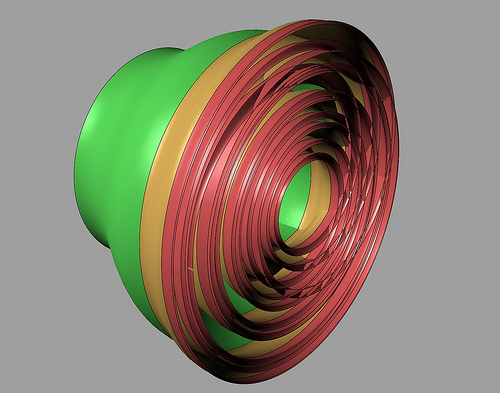
If we remove the red band we see how the orange one wrapped around
it 3 times:
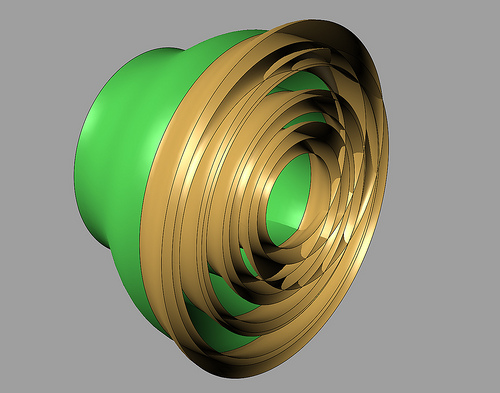
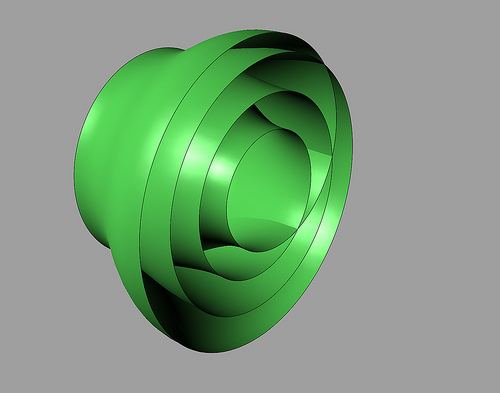
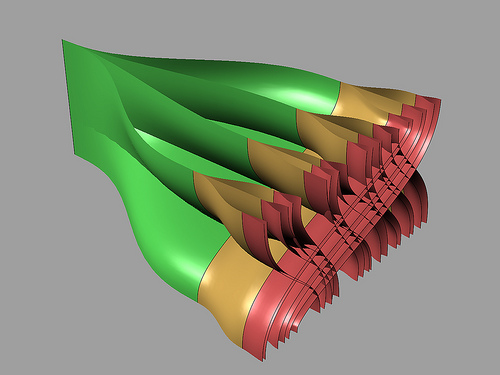
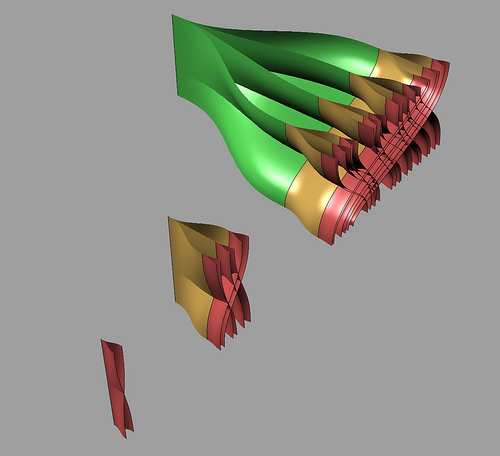
These pictures are done using Rhino 3D. Actually I'm using the beta version of their port to OS X. There's a function (called Flow) that lets you map a "spine" of an object to another curve to tell it how to deform the object. This is how I went from the chopped open version to the round one. It's also how I managed to make the orange wrap around the green and the red wrap around the orange.On the n-Category Café, Tom Leinster raised a useful point:
Something that bothered me for a while about rational homotopy, as an outsider, was this phrase "the homotopy groups are rational vector spaces". A priori the (higher) homotopy groups are abelian groups. So does this mean that there exists a rational vector space structure? That there exists a unique one? That one is somehow specified?Todd Trimble added:In fact, these questions are unnecessary, for the following reason. (I think this was explained to me by the James who sometimes comments here.) Fact:
Let A be an abelian group. Then A has the structure of a rational vector space in at most one way.So, despite appearances, being a rational vector space is a property of abelian groups, not extra structure.The proof is fairly straightforward, I think. If A admits a rational vector space structure then
for all a ∈ A and all positive integers n, there exists a unique b ∈ A such that nb=a.And this condition clearly determines what the scalar multiplication over Q must be. (In fact, it's an 'iff': an abelian group admits the structure of a rational vector space if and only if it satisfies this condition.)
Yes. A rational vector space is the same as a divisible torsionfree abelian group. Incidentally, an abelian group is divisible if and only if it is injective in the category of abelian groups, and is torsionfree if and only if it is flat in the category of abelian groups.
For more discussion visit the n-Category Café.
...the pursuit of science is more than the pursuit of understanding. It is driven by the creative urge, the urge to construct a vision, a map, a picture of the world that gives the world a little more beauty and coherence than it had before. Somewhere in the child that urge is born. - John Archibald Wheeler
© 2009 John Baez
baez@math.removethis.ucr.andthis.edu

|
 
|

|